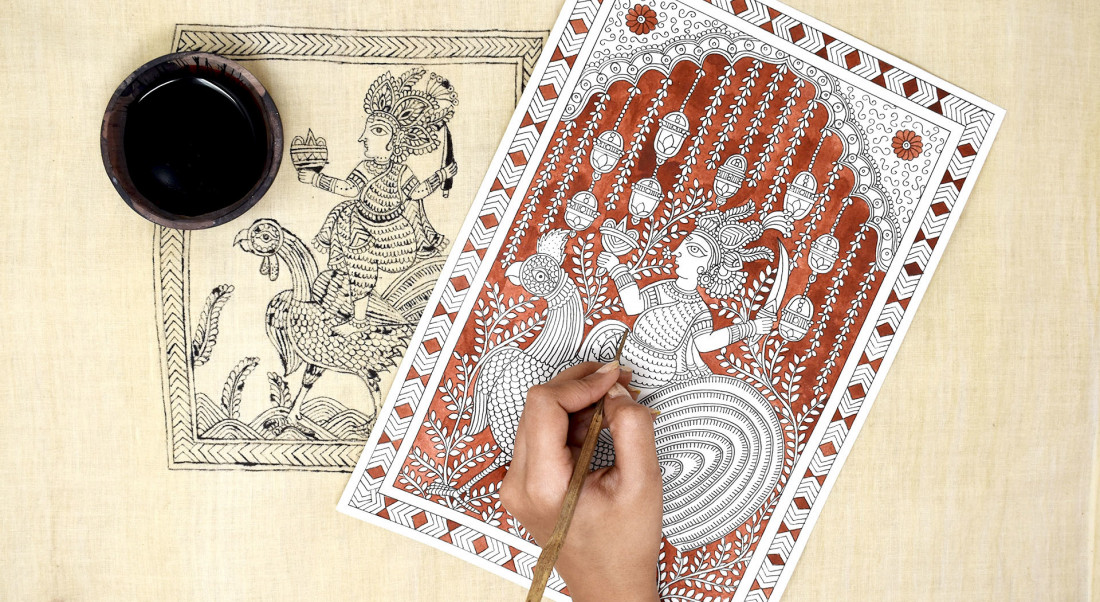Hailing from the state of Gujarat, Mata Ni Pachedi art literally means "behind the Mother Goddess". This textile-painting artform generally depicts images of the temple of the Mother Goddess on cloth. Due to its similarity with the Kalamkari art of South India, Mata Ni Pachedi art is also known as Kalamkari of Gujarat.
History of Mata Ni Pachedi Art
The origin of this art brings out one of the social evils of Indian society when the people from the nomadic Vaghari tribal community were denied entry to the temples. So they constructed their own shrines and painted the depiction of Mother Goddess on clothes and started worshipping them. That's why this art form is also considered sacred art. The Pachedi is also used as the canopy of the shrines and the paintings exhibit different forms of the Mother Goddess, flora, fauna, and narratives of folktales and mythology with Mother Goddess at the centre.
About the Art
These traditional temple hangings are a product layout of four to five pieces of rectangular cloth fabric. The fabrics are further divided into seven to nine columns along with a narrative format for making the interpretations on the cloth easy to understand. Like all other art forms, Mata Ni Pachedi art also has its own techniques and specific materials. Let us dig deep into technicalities.
Materials Required: The main ingredient is definitely a piece of cotton cloth cut into a rectangular shape. The figurines on the cloth are either drawn by hand or printed using wooden blocks. For colouring, the Kalam or the paint brushes are made of bamboo, and colours are made of natural dye which is prepared from the solution of alum mixed with tamarind seed powder and a deep red mordant called Alizarin. The black colour is prepared from iron.
Techniques of the Art: At first, the cloth is prepared by soaking in water, washing, and de-starching. Then it is treated with a solution of Harda (terminalia chebula). After the cloth is prepared, the painting is done on it. Traditionally, the painting is done strictly using two colours, deep red and black. The background of the cloth is used as the third colour. The black colour stands for the repellent of evil spirits and intensifier of spiritual energy while the red colour stands for the colour of blood (Rakta) which is believed to have healing power. The background colour of the cloth which is generally white stands for the symbol of purity.
The artist makes the outline of the cloth using black colour. The painting has a central figure of a female deity. The rest of the parts are arranged in a grid-like structure with architectural insertions like doors, archways in a specific format. The Sun and the moon are generally drawn in the top two corners of the cloth and other figures like singers, musicians, shamans or priests, animals, and birds are also drawn to signify the celebration of the Mother Goddess. The making of the figurines on the cloth is done using two techniques: Wooden-block printing and Free-hand painting. Some artists even use both methods. After the outlines of figures are made using black colour, the red colour is applied using bamboo brushes or Kalam to fill them which at first appears yellow due to the presence of non-permanent dye. The colour later develops into the red after treatment with the deep red mordant Alizarin.
Use of Alizarin and the Process of Dyeing: The mordant Alizarin along with dried Dhawda flowers are used for developing and fixing the red dye. The process of dyeing includes filling a big pan with water and adding the mixture of Alizarin and Dhawda flowers through a makeshift cloth pouch to ensure homogeneity. Then the artist boils the cloth in this solution for some time, and after that when it is taken out from it, the red colour is developed and visible.
Washing and Drying: After colouring, the fabric is washed in flowing water to wash out excess dyes. Traditionally, the cloth is washed in the flowing waters of the Sabarmati river. After washing, the drying should be done in moderate sunlight and low humid weather on an open surface as the natural dyes are climate-sensitive.
Uses of Mata Ni Pachedi
The sole reason for the emergence of this art form is to serve religious purposes. Other than being the substitute of idols of Mother Goddess in temples, Mata Ni Pachedi are also used on temple walls. At present, Mata Ni Pachedi art has been commercialized and is used as a medium of storytelling of the Mother Goddess and the primitive tribal lives and various folklores of the Vaghari people by designing it on saree, kurta, jackets, face masks room decorations like wall hangings.
Current Scenario
The present scenario of this 300-year-old artform is a matter of concern. The practice of the art form which was once the identity of a whole community has now been constricted to only three to five families in the world and all of them are residents of Ahmedabad. The present generation has inherited the techniques of the art from their ancestors and still is holding onto the legacy. They depend on the selling of the Pachedi in various exhibitions to make a living. Unfortunately, the Covid 19 pandemic has reduced the number of exhibitions and fairs. Such situations point out the importance of online buying and selling platforms and ArtsofIndia is such a platform that has come forward to the cause of the Mata Ni Pachedi artists and facilitated the selling of this sacred art to large numbers of people. The Government of India has also initiated the process of conserving it by registering it in the Geographical Indication Tag list. The Sardar VallabhBhai Patel International Airport of Ahmedabad also contains billboards of Mata Ni Pachedi art to spread awareness about the existing tribal art form of India.
Picture Source: insider.in



